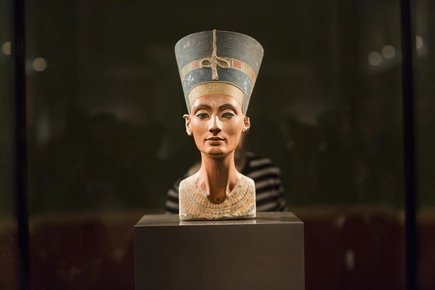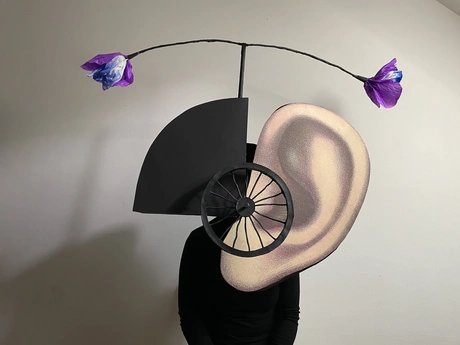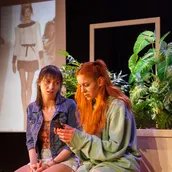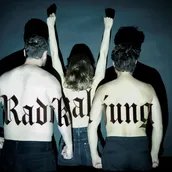
"The Story of an Ear That Turned Itself Deaf" is an interdisciplinary art project that combines theater, contemporary dance, and experimental costume design. In this performance, hearing is explored not only as a biological sense, but as a social and political phenomenon. The production poses the question of the role that listening—or the intentional non-listening—plays in social coexistence.
At the center of the performance is an ear that turns itself deaf—an absurd, yet simultaneously frighteningly apt metaphor for the selective perception of our time. In a world where information is abundant and every voice struggles to be heard, many people instinctively decide to hear only what fits into their existing worldview. This selective deafness is not an individual phenomenon, but a collective mechanism of demarcation that promotes misunderstandings, social divisions, and indifference.
The artistic realization uses a vivid language: large, grotesque ears grow from the performers' heads, but are Functionless – decorative, exaggerated, ironic. They represent a society that constantly talks about communication but is increasingly incapable of truly listening. The performers' bodies move in choreographed patterns between approach and defense, between making contact and withdrawing.
Movement replaces words, for the performance is entirely language-free – a conscious renunciation that also attunes the audience to a different way of perceiving. The absence of spoken language creates a special openness to different approaches. The performance is explicitly aimed at people with hearing impairments and those who do not have a good command of German.
The nonverbal structure enables a universal form of communication that functions not through words, but through images, rhythm, gesture, and physicality. Listening here becomes seeing – perception in the broader sense. Thematically, the focus expands from the individual level to social structures.
- What does it mean for a society when its members no longer want to listen to each other?
- What forms of ignorance arise from this attitude?
- And What social consequences arise when the capacity for empathy is overwhelmed by a flood of stimuli, opinions, and distractions?
The performative space is not understood as a mere stage, but as a living resonance chamber in which meanings emerge, shift, are questioned, and renegotiated. The audience is invited to perceive themselves as part of this communication system—as hearing, seeing, judging beings.
The production reflects not only the performers, but also the audience themselves: their expectations, their reactions, their willingness to engage. Costume design plays a central role in the aesthetic concept of the work. The costumes are made of recycled materials, including metallic, shiny surfaces that, on the one hand, create a cool distance, while, on the other, revealing a certain vulnerability through their close proximity. The ears—in different sizes and shapes—develop a life of their own, becoming expressions of inner states and collective dynamics. They hang limply, they straighten up, they vibrate, or close. In doing so, they lose their biological identity. Self-evidence becomes signs – oversized, absurd, poetic.
The work operates at the intersection of dance theater, performance art, and installation-based visual language. It is as much a physical act as a conceptual one. The choreography is composed of fragments, of movement patterns that sometimes appear rhythmic, sometimes halting, sometimes in sudden impulses – a physical stuttering that makes visible the breaks in communication.
"The Story of an Ear That Turned Itself Deaf" is thus also a narrative about responsibility: the responsibility to listen, even when what is being said is uncomfortable. The responsibility to remain present, even when retreat seems easier. And the responsibility to be part of a conversation that consists not only of words, but of gestures, glances, silence – and the willingness to be touched.
Additional information
Artist and director Venera Kazarova
Composer Alyona Toimintseva
Performers Andrea Salussoglia, Caro Gonzales, Anne Langner, Pauli Chabier
Playwright Andrey Stadnikov
Producer Angela Fegers
Venera Kazarova Contemporary Artist, Costume and Performance Designer. Venera
Kazarova works at the intersection of visual and performative art. Originally trained
as a costume designer, Kazarova focuses on creating designs that convey messages
and ideas, using costumes as central elements in her performances.
https://www.instagram.com/venera_kazarova/
Carolina González is an Ecuadorian artist based in Berlin. She has been
exploring movement through dance for about 10 years, practicing styles such as
classical dance, modern dance, jazz, Latin American folklore, and contemporary
dance. Carolina graduated from the Conservatory of Arts "Metrodanza" in Quito
and continued her training at the Berlin Dance Institute (BDI).
https://www.instagram.com/caro__gt/
Paulina Chabier was born in Poland, where she earned a bachelor's degree in
French language and culture. She moved to Germany to pursue a career in
dance and, in 2023, graduated from the Berlin Dance Institute, where she
trained in contemporary dance and modern techniques.
https://www.instagram.com/paulichabi/
Andrea Salussoglia is a contemporary freelancer dancer and performer from
Turin ( Italy) and active in Europe. Born in Italy he graduated at MoveOn
Performing Arts Academy in Milan, and has received a BA at the faculty of the
Berlin Dance Institute. Since then, Andrea has been working with
choreographers as Davide Manico, Nikolas Lagousakos, Luana Rossetti,
Joseph Tmim and Jessica Gaynor.
https://www.instagram.com/andreasalussoglia/
Anne Langner is a contemporary dancer and performer with a passion for
exploring movement through innovative and expressive choreography. With a
background of the Berlin Dance Institute. Marieann specializes in performance
and improvisation techniques.
https://www.instagram.com/marieannlangner/
Alena Toymintseva is a visionary jazz artist and composer.
Her talent has been recognized with numerous accolades and awards,
including two champion titles at the World Championship of Performing Art
(WCOPA) in Hollywood, CA.
In addition to her live performances, Alena has released two albums. Her latest
album, 'To Heavenly Father and Mother Nature,' was released during the first
lockdown in the UK amid the pandemic.
https://www.instagram.com/alenajay/
Composer Alyona Toimintseva
Performers Andrea Salussoglia, Caro Gonzales, Anne Langner, Pauli Chabier
Playwright Andrey Stadnikov
Producer Angela Fegers
Venera Kazarova Contemporary Artist, Costume and Performance Designer. Venera
Kazarova works at the intersection of visual and performative art. Originally trained
as a costume designer, Kazarova focuses on creating designs that convey messages
and ideas, using costumes as central elements in her performances.
https://www.instagram.com/venera_kazarova/
Carolina González is an Ecuadorian artist based in Berlin. She has been
exploring movement through dance for about 10 years, practicing styles such as
classical dance, modern dance, jazz, Latin American folklore, and contemporary
dance. Carolina graduated from the Conservatory of Arts "Metrodanza" in Quito
and continued her training at the Berlin Dance Institute (BDI).
https://www.instagram.com/caro__gt/
Paulina Chabier was born in Poland, where she earned a bachelor's degree in
French language and culture. She moved to Germany to pursue a career in
dance and, in 2023, graduated from the Berlin Dance Institute, where she
trained in contemporary dance and modern techniques.
https://www.instagram.com/paulichabi/
Andrea Salussoglia is a contemporary freelancer dancer and performer from
Turin ( Italy) and active in Europe. Born in Italy he graduated at MoveOn
Performing Arts Academy in Milan, and has received a BA at the faculty of the
Berlin Dance Institute. Since then, Andrea has been working with
choreographers as Davide Manico, Nikolas Lagousakos, Luana Rossetti,
Joseph Tmim and Jessica Gaynor.
https://www.instagram.com/andreasalussoglia/
Anne Langner is a contemporary dancer and performer with a passion for
exploring movement through innovative and expressive choreography. With a
background of the Berlin Dance Institute. Marieann specializes in performance
and improvisation techniques.
https://www.instagram.com/marieannlangner/
Alena Toymintseva is a visionary jazz artist and composer.
Her talent has been recognized with numerous accolades and awards,
including two champion titles at the World Championship of Performing Art
(WCOPA) in Hollywood, CA.
In addition to her live performances, Alena has released two albums. Her latest
album, 'To Heavenly Father and Mother Nature,' was released during the first
lockdown in the UK amid the pandemic.
https://www.instagram.com/alenajay/
Dates
October 2025
| Mo | Tu | We | Th | Fr | Sa | Su |
|---|---|---|---|---|---|---|
1
|
2
|
3
|
4
|
5
| ||
6
|
7
|
8
|
9
|
10
|
11
|
12
|
13
|
14
|
15
|
16
|
17
|
18
|
19
|
20
|
21
|
22
|
23
|
24
|
25
|
26
|
27
|
28
|
29
|
30
|
31
|






